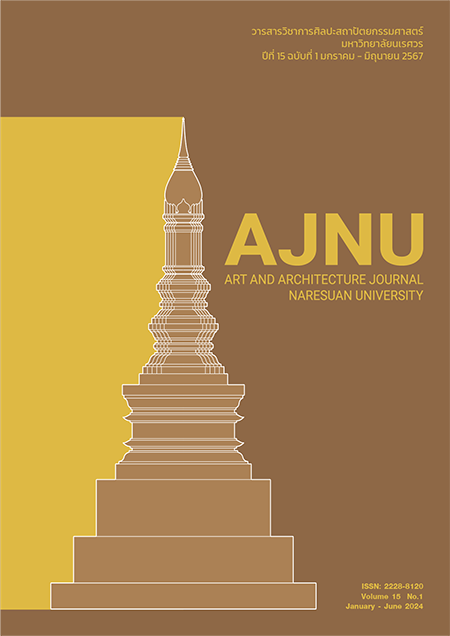Disseating the beauty of Sin teen jok Doi Tao to meet development process in the era of Covid – 19
Main Article Content
Abstract
This research relates to Doi Tao,The purposes of this academic article are 1. Studying the background of patterned Phasin Tin Jok Doi tao. 2. Studying the marketing methodology and mechanisms of selling Phasin Tin Jok Doi Tao during Covid-19. “Doi Tao”a small district in Chiang Mai. When talking about Doi Tao, the song “Young boy from Doi Tao” is probably the first thing people think of. Not many people know that Doi Tao also produces beautiful patterned Phasin Tin Jok that has been known for “The Queen of Phasin” named by Asst. Prof. Wiluck Sripasang. Tin Jok from Doi Tao has been quite unpopular nowadays, although the pattern of Doi Tao’s phasin was very exquisite in the past. Stories have been interpreted through Tin Jok’s various designs and patterns. There’s a chance that the weaving culture will become extinct. Sometimes people call Doi Tao’ phasin "Sin Nam Tuam (flooding phasin).” At present, Doi Tao’s phasin has gained more attention from the new generation as they continue to weave for their community. Even though Doi Tao’s phasin is expensive. The group’s sale method is considered innovative. When listing in online platforms, the products are well-received and sold out immediately regardless of an expensive price in terms of the pattern. It has been selling well. The fabric is usually sold out after being listed in the market. All fabric patterns are related to Buddhism and lifestyles of the locals. However, when COVID-19 hit the world, the fabric stops selling as the purchasing power has been declined. This paper is, therefore, the continuation of designing fabric patterns that are contemporary, leading to the adaptation of weaving process for a simpler weaving method. The author therefore analyzes the structure of Doi Tao’s phasin and its pattern. The author sincerely hopes that this article will be useful for those who are studying the design of woven fabric’s patterns to further their studies in designing. The sale process of the group is considered to be innovative but if the product is adjusted, studies the consumers needs, adds marketing awareness to local villagers, distributes knowledge from the leaders of the weaving group to the villagers in the community, Phasin Doi Tao will definitely be able to develop and adapt.
Article Details

This work is licensed under a Creative Commons Attribution-NonCommercial-NoDerivatives 4.0 International License.
References
กรมศิลปากร. (2515). สมบัติศิลปจากบริเวณเขื่อนภูมิพล. กรุงเทพ : กรมศิลปากร.
ก้องเกียรติ มหาอินทร์, พฤทธิ์ศุภ เศรษฐศิริ, นพดล อินทร์จันทร์ และ กิตติกรณ์ นพอุดมพันธุ์. วัฒนธรรมการนุ่งซิ่นตีนจกแม่
แจ่ม จังหวัดเชียงใหม่ : สถานภาพในการดำรงอยู่. ใน อัครพนท์ เนื้อไม้หอม (บ.ก), รมยสาร คณะมนุษยศาสตร์และ
สังคมศาสตร์. (หน้า 44). บุรีรัมย์ : สำนักพิมพ์มหาวิทยาลัยราชภัฏบุรีรัยม์.
ทรงศักดิ์ ปรางค์วัฒนากุล และแพทรีเซีย ซีแมน. (2530). ผ้าล้านนา ยวน ลื้อ ลาว. เชียงใหม่: โครงการศูนย์ส่งเสริม
ศิลปวัฒนธรรม มหาวิทยาลัยเชียงใหม่
ปฐมหงส์ สุวรรณ. (2558). ผ้าทอในวิถีชีวิตไทย – ไท. กรุงเทพ: สถาบันไทยศึกษา จุฬาลงกรณ์มหาวิทยาลัย.
รตินันท์ สินธวะรัตน์. (2562). ไทยวนในความทรงจำ ณ หอวัฒนธรรมพื้นบ้านไทยวน สระบุรี. เข้าถึงเมื่อ 8 กุมภาพันธ์
(2565). จาก https://www.gourmetandcuisine.com/stories/detail/328.
วิลักษณ์ ศรีป่าซาง. (2559). การสร้างคุณค่าอัตลักษณ์เพื่อเพิ่มมูลค่าผ้าทอล้านนาโบราณ กรณีศึกษา“นางพญาแห่งผ้าซ่ิน”.
โครงการประชุมวิชาการบริหารธุรกิจ และศิลปศาสตร์ ระดับชาติ ครั้งที่ 2. เชียงใหม่ : คณะบริหารธุรกิจและศิลปะศาสตร์
มหาวิทยาลัยเทคโนโลยีราชมงคลล้านนา, 2(2), 1-15.
วิบูลย์ ลี้สุวรรณ. (2559). พจนานุกรมผ้าและเครื่องถักทอ. นนทบุรี: สำนักพิมพ์เมืองโบราณ.


